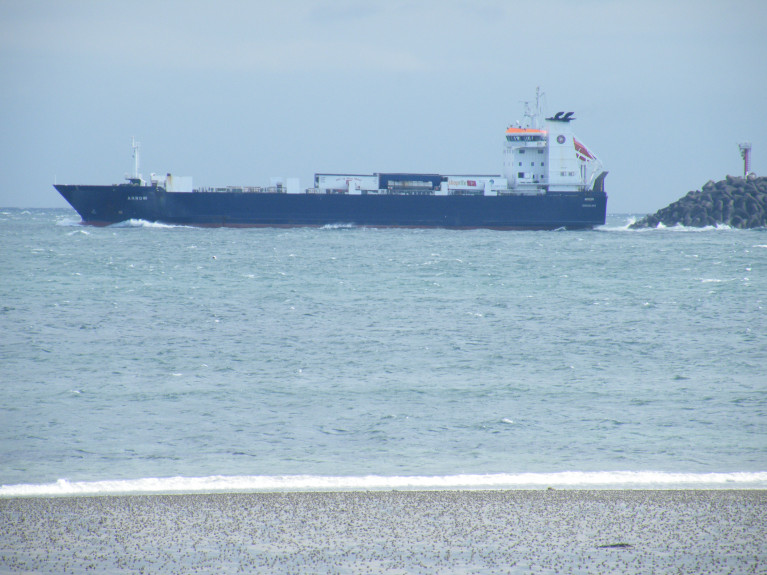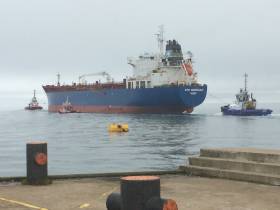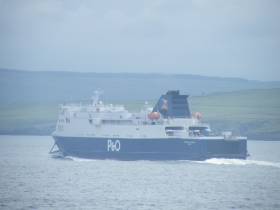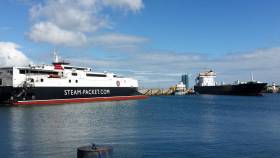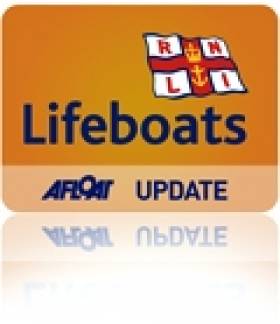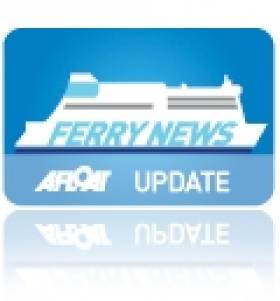Displaying items by tag: Port of Larne
Afloat tracked yesterday Irish Sea freight ferry MV Arrow to the Port of Larne, having departed Douglas Harbour on Sunday, however the crossing was separate to any requirements of the Isle of Man Steam Packet, writes Jehan Ashmore.
According to a spokesperson on behalf of the IOMSPCo, the chartered in ro-ro vessel MV Arrow was brought to Manx waters to assist with additional freight prompted by adverse weather conditions over the weekend. The bad weather been in the form of Storm Arwen.
Prior to Arrow's arrival at the Co. Antrim ferry port (see Brexit Boost story) the freighter carried out duties for the Steam Packet's main route from Heysham to Douglas. This took place (in the early hours) of Sunday morning to assist with freight demand using the vessel's 1,057 lane metres of freight, which equates to approximately 65-trailer units.
As the Steam Packet website also cited, the charter was also due to disrupted sailings at the weekend with Friday's Ben-my-Chree (conventional ferry) sailings to Heysham which were cancelled for the same reason.
It is almost a decade since Seatruck Ferries placed Arrow into a long-term charter agreement with the IOMSPCo as an additional support vessel for freight or as an emergency replacement vessel. More recently the ship which is now owned by investment bank Fortress, continues however to retain a link with Seatruck Ferries which provides crewing and management.
In addition, the Arrow's routine back-up role took hold of such circumstances by providing transport of essential food and goods for islanders. Also the re-deployment of the freighter released more ferry vehicle deck space for motoring passengers affected by the weather disruption once ceded.
Following discharge of freight traffic at the Manx capital, Arrow set off late in the morning of last Sunday and arrived at the Port of Larne some seven hours later.
Arrow usually when not operating on short-term charters to other companies goes into lay-over mode in Larne by berthing at the Continental Quay and without impacting other users. The port's relative proximity permits a short passage time between Northern Ireland and the Isle of Man.
In the meantime, Arrow currently remains in Larne where P&O Ferries runs the shortest and fastest crossing to Scotland on the North Channel route that takes just 2 hours. To enable 12 departures a day, ropax pair European Causeway and half-sister European Highlander operate the link.
This route is in competition with Stena Line though out of Belfast Harbour on a slighty longer passage time of 2 hours 15 minutes and served by Superfast's VI and VII respectively.
Whereas, Seatruck, the Irish Sea's only dedicated freight operator this year celebrated its 25th anniversary of operations having revived Merchant Ferries Warrenpoint-Heysham route in 1996 with the newcomer's first crossing from Carlingford Lough was undertaken by Bolero.
This vessel was chartered in on the Co. Down-Lancashire link and what stemmed from this service, steadily grew and led to an expansion of routes across the Irish Sea.
Towage Trio Assist Biggest Ship to Port of Larne Depart Following Routine Maintenance
#Ports&Shipping - At 184m in length, CPO Germany which became the biggest ship ever to dock in the Port of Larne, departed the Co. Antrim port recently following routine maintenance, writes Jehan Ashmore
The London registered tanker at almost 20m longer than the port's regular ferry customers became the longest to berth. The ferries European Causeway and European Highlander which are near-sisters operate P&O Ferries route to Cairnryan on the North Channel.
Port of Larne is building a reputation in accommodating ships of all sizes and in managing an increasing amount of cargo, project cargo (i.e. wind turbines) and the aforementioned maintenance service to its portfolio in addition to other non-ferry related work.
Handing the operations of CPO Germany required the Port of Larne along with the Doyle Shipping Group (DSG). Among the duties required involved the deployment of tugs for the departure of the tanker. This saw a tug/workboat from the John McLoughlin & Son fleet located in the port joined by two tugs based in neighbouring Belfast Harbour.
As seen in the above photo at the tanker's bow is the red-hulled Merchantman. The 24.4m ASD bollard pull tug of 72 tons is based in Belfast Harbour and operated by SMS Towage that began business in the port during 2013. SMS Towage is an East Yorkshire company located in Hessle. The town is close to the Humber Bridge which is upriver of Kingstown-upon-Hull.
As previously reported on Afloat, ABP's Port of Hull invested in of a pair of Irish built ship-to-shore container cranes installed at the fourth busiest trading estuary in Europe. Afloat will have more to report on SMS operations at the UK North Sea port.
Port of Larne Handles Biggest Ever Vessel at 184 Metres
The Port of Larne, one of the busiest ports on the Irish Sea capable of handling a wide range of cargoes and ships, welcomed the CPO Germany into port this month for routine maintenance.
The vessel which regularly delivers products across Europe and further afield is understood to be the biggest single screw tanker ever, with an overall length of 184 metres, nearly 20 meters longer than ships normally handled by the port.
Anthony Van Damme, Harbour Master Port of Larne said: "The Port of Larne continues to build a reputation for the versatile approach we take in accommodating ships of all sizes and in managing an increasing amount of cargo, project, maintenance and other non-ferry related work.
"The vessels arrival required some quick and thorough planning from Larne Harbour staff, in particular, the Marine and engineering departments, the ships agent, Larne Pilots, towage provider and linesmen. With just one engine, the tanker is not as easily maneuverable as the regular ferries that call into Larne and therefore required a considerable amount of support to enable it to come into port safely but we have a first class team here focused on providing speedy solutions to customers and the whole process went very smoothly and safely."
The Doyle Shipping Group were tasked by the owners of CPO Germany to come up with a suitable operational plan, Sean McCready, Managing Director in Belfast said: “Through the quick and effective response given by Larne Harbour, the owners were able to complete all their operational requirements in a timely and cost-effective manner and were very happy with all aspects of the operations completed. Thanks go to Anthony and all the team for their efforts.”
Larne Port has over 40 acres of storage area in and around the port and easy access to the rest of Northern Ireland and beyond thanks to the A8 dual carriageway, we make a great choice for project cargoes, bulk cargoes and passenger traffic.
Freight Figures 'Highest' Boost for Port of Larne
#ferry - The highest number of lorries and trailers travelling on P&O Ferries between Larne and Cairnryan was reached in the third quarter of the year than it has in any Q3 since 2011.
As the News Letter writes the ferry company carried 53,305 lorries and trailers on its ships in the months of July, August and September - a 3.3 per cent increase on the same quarter last year.
Neal Mernock, P&O Ferries Sector director on the Irish Sea, said: “We are delighted that more and more freight customers are experiencing for themselves the benefits of transporting goods between Northern Ireland and Britain with us.
“Our port at Larne is fast becoming the gateway of choice for anyone exporting to or from Ireland. It has outstanding connections via rail and road, especially after the upgrading of the A8 dual carriageway, and is nine miles closer to Scotland than the port at Belfast.”
P&O Ferries operates seven sailings a day between Larne and Cairnryan using two 21,000 ton sister vessels, European Causeway and European Highlander. The regular daily service, the company notes, provides a bridge for goods being transported between Northern Ireland and the Republic of Ireland to Britain, and also on to the continent via its connecting services from Dover, Tilbury, Hull and Teesport.
For more on this story, click here.
Changes to Northern Ireland-Isle of Man Ferry Dropped
#ferrynews - Plans to overhaul ferry services between Northern Ireland and the Isle of Man have been dropped writes BBC News after a three-week public consultation.
The Steam Packet Company had considered re-routing sailings (as previously reported on Afloat) to the port of Larne instead of Belfast Dock.
A spokesman said Larne could better accommodate heavier vehicles such as vans, motor homes and coaches.
Despite this, the consultation showed that passengers preferred the "convenience" of sailing to Belfast.
While the route will remain unchanged for the duration of 2018, the Steam Packet company said discussions will continue to improve facilities at Belfast.
"If those upgrades cannot be undertaken it will make sense for the Isle of Man if we look again at Larne to provide a service for larger vehicles", said company chief Mark Woodward.
#ferry -The Isle of Man Steam Packet Company has launched a public consultation as the operator is considering running services to and from Larne, Northern Ireland.
As previously reported on Afloat the ferry Ben-My-Chree in recent weeks undertook berthing trials took at the Co. Antrim port that they claim will help boost visitor and other traffic.
Currently the Steam Packet operates into Albert Quay, Belfast, but is investigating the merits of relocating to Larne, which could provide a service for heavier vehicles such as vans, motorhomes, coaches and freight that cannot be accommodated through Belfast.
A professional research company has been engaged to conduct a public survey, which it is hoped people who have used the Douglas-Belfast route will respond to.
The survey which is open to all, is available online, with links shared from the Steam Packet Company’s social media channels and shared directly with some customers who have used the route. The consult the survey click this link: www.islandglobalresearch.com/steampacketsurvey . The survey is expected to run for three weeks.
Isle of Man Steam Packet Company Chief Executive Mark Woodward said: ‘We constantly review our routes to ensure the best passenger experience possible is offered. We have identified that Larne could deliver an enhanced service compared with the Belfast facilities, but we want to know what our passengers think.
‘We would like anyone who has used the route, or might intend to, to share their views. We want to hear all opinions on Albert Quay and Larne, good and bad, as passenger feedback will be a central factor in the final decision.’
This year both Ben-my-Chree and fast craft Manannan have visited Larne to ensure the berthing facilities are suitable for both vessels.
Isle of Man Operator to Take Berthing Trials In Northern Irish Port
#Larne - The Isle of Man Steam Packet is to undertake berthing trials in the Northern Irish port of Larne, writes IOM Today.
The fast craft Manannan is to used as the company assesses the suitability of alternative ports ’to allow for flexible and robust contingency planning’.
Similar to the trials conducted at Holyhead in 2016.
Manannan will return to service on March 31.
After spending the winter in Manx waters, where annual maintenance procedures were undertaken, the vessel is scheduled to sail to Merseyside on March 1 for dry docking and other specialist work before resuming daily services between Douglas and Liverpool.
The Steam Packet has previously operated sailings between Larne and Douglas during the TT festival, using the charter fast craft P&O Express.
A freight-only ferry, Seatruck's ro-ro Arrow on charter to the Steam Packet adds Afloat has been wintering in Larne that has a uniquely rail-connected integrated ferryport terminal. The Arrow has been used to support the operator's ropax ferry Ben-My-Chree during busy periods on island's main route to Heysham.
To read more from the Manx newspaper click here.
Rail & Sail Terminal But Only At Port of Larne
#RailSail – The Port of Larne has the only integrated railway and ferry terminal on the island of Ireland, unlike Irish Rail's operated Rosslare Europort, writes Jehan Ashmore.
In more recent times the Rosslare Harbour railway platform was relocated away from the combined terminal. This is in stark contrast to the Co. Antrim ferryport operated by Larne Harbour Ltd (part of the P&O Ferries group) which is directly connected to Translink NI Railways route network linking Belfast.
Passengers can make convenient rail and sail access at Larne. On the North Channel is where P&O Ferries operate the Larne-Cairnryan service. On the Scottish side at Cairnryan there is however no railway station unlike Welsh ferryports of Fishguard and Pembroke that link Rosslare Harbour.
One of the Larne-Cairnyan ferry sisters the ropax European Highlander assisted the Larne RNLI on a call-out last Sunday. This involved all-weather lifeboat ALB Dr John McSparron evacuate a casualty with medical difficulties from a 160m bulk carrier some nine nautical miles offshore.
In port this morning asides the ferry traffic is berthed freight-ro-ro ferry Arrow, which since December has been ‘wintering’ on an intermittent basis.
Arrow is part of the Seatruck Ferries fleet, however the vessel in recent years began a charter to the Isle of Man Steam Packet Co. This is to provide back-up support to the island’s main ferry, ropax Ben-My-Chree that operates Douglas-Heysham sailings.
The Port of Larne in recent months has seen cargoships arrive loaded with components for wind-farm projects. Among the callers was BBC Magellen (2010/5,344grt). The ship had wind turbine blades loaded at Emden, Germany.
A fleetmate of the BBC Chartering owned vessel, BBC Orion had docked last week at the Port of Waterford. The call saw the first batch of tower sections for wind-farms projects that are to be repeated throughout the year.
Donaghdee RNLI Remembers Princess Victoria Tragedy 60 Years On
#RNLI - The sinking of the Princess Victoria on 31 January 1953, with the loss of 135 lives, was the worst maritime disaster in the waters of the British Isles.
The Donaghadee lifeboat Sir Samuel Kelly rescued 34 from the disaster which occurred in the North Channel en route to the Port of Larne, with its coxswain Hugh Nelson being awarded a Bronze Medal and the British Empire Medal for the skill, courage and initiative shown during the rescue.
The Sir Samuel Kelly still lies in Donaghdee, and last weekend a number of events were organised to raise funds and awareness of the need to find a permanent sheltered home for this historic lifeboat.
A marquee supplied by Ards BC had been placed next to the Sir Samuel Kelly and a committee of local supporters organised a weekend of events.
On Friday 25 January a talk to local school children was followed in the evening by a commemoration concert which featured the Donaghadee Male Voice choir and the Festival Brass Band.
On Saturday evening there was a film show with a Pathé news clip from 1953 showing the Kelly bringing in survivors followed by a 1953 film Gentlemen Prefer Blondes.
Sunday saw the Donaghadee RNLI Saxon crew going to sea to lay a wreath at the spot where the Princess Victoria sank. They were joined by lifeboats from Larne and Portpatrick, and a short service of remembrance was led by Donaghadee 1st Presbyterian minister Colin Anderson.
On returning to harbour, the crews joined a combined church service of remembrance in the marquee with over 350 people in attendance. All funds raised will go to the Sir Samuel Kelly Restoration Fund.
Port Out Starboard Home as Olympic Torch Travels P&OSH
#OLYMPIC FERRY– With 50 days to go to the start of the London Olympic Games, the torch-relay is to depart Northern Ireland this afternoon with P&O Ferries on the North Channel service to Scotland, writes Jehan Ashmore.
Before the flame reaches the Port of Larne, 67 torch-bearers will have carried the torch today on a near 120 mile journey across the north having departed Newcastle this morning.
A highlight of the day was a water crossing on Lough Neagh, where the flame was carried by the boat Island Warrior on the largest lake on the island of Ireland. Eorann O'Neil from Crumlin had the honour of torch-bearer and the 16 year-old was nominated for his dedication to swimming.
When the torch with its accompanying escort of support vehicles arrives in Larne mid-afternoon, the flame will be taken to an event to mark it leaving Northern Ireland. An hour later the torch's motorcade is to head for the port to board the P&O conventional ferry European Highlander on the 16.30hrs sailing for Cairnryan in Galloway. The 21,188grt ferry will arrive at the port on Lough Ryan some two hours later.
Tomorrow morning sees the start of the first relay in Scotland which is scheduled to start at 06.08hrs and takes place further down along Lough Ryan at the former ferryport of Stranraer.
The ferryport closed last November when Stena Line switched Scottish ferry terminals to Cairnryan, where sailings to Belfast are still maintained by a pair of 30, 285grt 'Superfast' sisters. Close to the new €80m Stena terminal is the existing terminal that serves P&O's operations.
Tomorrow's torch returns to Cairnryan as the relay route heads northwards to Glasgow which marks the day's final destination. After the torch completes touring Scotland the relay will cross the border to England to head back to London 70 days after originally embarking on a tour of the UK and detour to Dublin. The capital has been the only location visited by the torch relay outside that of the UK and Greece.


























